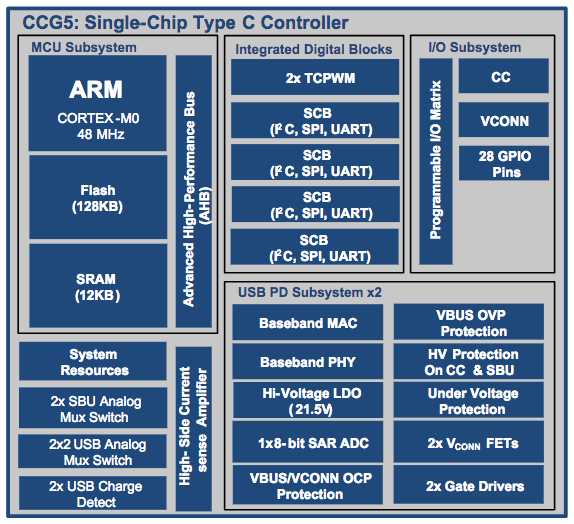By Warren Miller, contributing writer
USB-C is the next big thing in hardware interfacing. Intel’s ThunderBolt 3 design ecosystem features USB-C ports and connectors capable of transmitting data at up to 40 Gigabits per second (Gbits/s) while decreasing power consumption by half. Cypress Semiconductor Corp. recently announced its own programmable, two-port USB-C controller compatible for use with the Thunderbolt 3 platform.
According to Cypress, the EZ-PD CCG5 is the first two-port USB-C controller on the market that supports Thunderbolt 3 controllers. It boasts built-in protection against shorts and electrostatic discharge while helping with bill-of-materials (BOM) integration to simplify design and inventory. The device also includes 128 KB of flash memory to support a fail-safe boot-up and firmware upgrades.
The EZ-PD CCG5 supports downstream, upstream, and dual-role ports and fully supports the Power Delivery 3.0 specification. Two timers, counters, PWMs, and up to 28 GPIOs are also fully integrated. The device also includes 20-V regulators, sideband and USB high-speed muxes, high-voltage FET gate drivers, and hardware dedicated to protecting the system from overvoltage, undervoltage, and overcurrent fault conditions to form a one-chip solution for USB-C integrated platforms.

“The combination of Thunderbolt 3 and USB-C allows a notebook to drive multiple 4K displays while simultaneously charging the notebook over the same port,” said Ajay Srikrishna, vice president of Cypress’s Wired Connectivity Business Unit. “As part of the Thunderbolt 3 design ecosystem, our programmable, two-port EZ-PD CCG5 controller is helping to drive the proliferation of USB-C in desktop and notebook PCs, docking stations, and peripherals.”
The programmable capabilities offered by the EZ-PD CCG5 should not be overlooked. The highly integrated Arm Cortex-M0-based controller includes enough flash memory to hold two firmware images, supporting a fail-safe boot and update process. This capability means that features can be easily modified in the field to provide updates to evolving standards, bug fixes, efficiency improvements, customization for key customers, and a host of other possible new feature additions. This can dramatically improve the lifetime of a product and deliver increased value to the customer.
Advertisement
Learn more about Electronic Products Magazine





